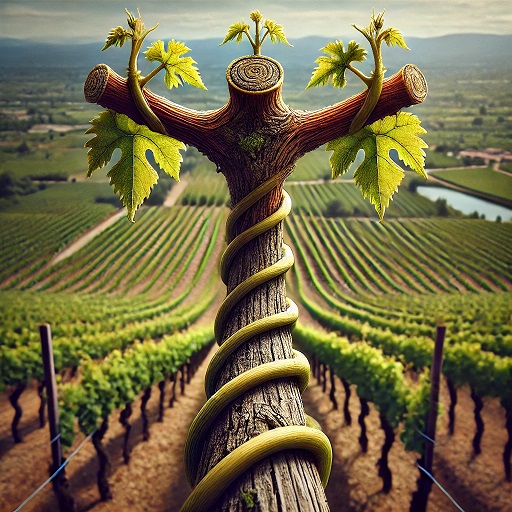Canopy Management
Pruning, Training and Trellising


Grapevines must be pruned and trained annually to achieve this goal.
Canopy Management
May-August (Nov-Feb)

Canopy managment is about designing the architecture of a grapevine.
Canopy refers to leaves, shoots and fruit.
Canopy managment is about designing the architecture of a grapevine to guide its energy into the ultimate result of perfectly mature fruit. Most of the canopy management takes place from May to August (South: November-February).
Canopy Management Benefits
- Optimize the yield
- Improve the fruit quality
- Improve the sunlight exposure
- Provide good air circulation
- Reduce the risk of diseases
Canopy Management Methods
- Trellising
- Pruning
- Cluster Thinning
- Shoot positioning
- Leaf Removal
Canopy Management
The term Canopy refers to the grapevine structure that is above the ground.
Canopy management is the manipulation of grapevine canopies (buds, shoots, leaves, fruit) to optimize the production of quality grapes (according to the microclimate surrounding them).
Grapevine training, pruning and trellising affects the quantity of sunlight recieved by the vine. Different shapes determine the presentation of the leaf area to incoming radiation.
Profitable grape production requires that grapevines be managed so that a large crop of high-quality fruit is produced each year.
An ideal training strategy centers around the arrangement of plant parts, to develop a better plant architecture that optimizes the utilization of sunlight and promotes productivity.

Canopy Components
- The Roots
- The Craft Union
- The Trunk
- The Head
- The Cordons
- The Shoots
- The Canes
- The Spurs
- The Tendrils
- The Leaves
- The Flowers
- The Fruits
The roots are multi-branched structures that grow down to various depths into the soil and anchor the vine. Roots absorb water and nutrients from the soil, store carbohydrates and produce the hormones that regulate vine growth.
Where the vine was crafted
The main stem of the vine
The end (top) of the trunk
The cordons are extentions from the trunk, and the part where additional arms and eventually leaves and grape clusters will extend.
The cordons are usually trained along wires as part of a trellis system. This training usually fixes the cordon into a permanent position, such as horizontal extending from the trunk.
The brances tha grows off the cordons are called shoots, canes or spurs.
The Shoots are the stalks extending from the cordon.
Canes are mature shoots after leaf fall. Green summer shoots that have matured into brown and woody shoots.
A cane pruned back to one, two, or three buds.
Canes are larger and 1-2 years old, while spurs are smaller and younger.
Structures that coil around smaller objects (trellis wires, small stakes, and other shoots) to provide support for growing shoots.
The Cordons

Shoots
A shoot consists of stems, leaves, tendrils and fruit. Shoots arise from buds from the previous growing season. The shoots are pruned in the process of "shoot thinning" to control grape yields.


Spurs
Tendrils

The shoot produces tendrils. These are structures that coil around smaller objects (i.e., trellis wires, small stakes, and other shoots) to provide support for growing shoots.
Tendrils grow opposite a leaf at the node, except the first two or three leaves at the base of the shoot. Thereafter, tendrils can be found opposite leaves, skipping every third leaf. Flower clusters and tendrils have a common developmental origin (Mullins et al., 1992), so occasionally a few flowers will develop on the end of a tendril.
Some Definitions
Planting density
The number of plants planted in a determined area.
Example: Average planting destiny in Burgundy is 8,000-10,000 vines per hectare.1-year-old wood (aka cane)
The previous year's shoot.
Example: The buds on a cane will be shoots, tendrils and leaves.Hectares vs Acres
1 acre = .4 Hectares / 1 hectare = 2.5 acres.Factors defining density
Water and NutrientsTranspiration
The warmer the climate, the faster water evaporates from the leaves. With high transpiration, lower density planting is needed.Fertile Soil
Barely fertile soil is more desirable for viniculture.Inflorecence
Clusters of flowers before they become flowers.Yield
Yield mesures quantity of grapes.
Tonnes per hectare. Hectoliters per hectare.Veraison
The onset of ripening. When grapes changes color.
Sugar increase. Acidity decrease.
Tannin develop and become less astringent.Green Harvesting
Dropping underdeveloped grapes. Reduce yield.
Must be done ofter veraison.